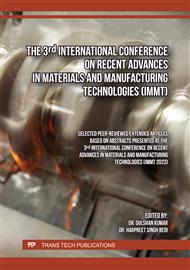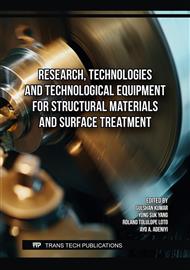[1]
Bagudanch I, García-Romeu ML, Ferrer I, Ciurana J. Customized cranial implant manufactured by incremental sheet forming using a biocompatible polymer. Rapid Prototyp J. 2018;24(2):120–9.
DOI: 10.1108/RPJ-06-2016-0089
Google Scholar
[2]
Alinaghian M, Alinaghian I, Honarpisheh M. Residual stress measurement of single point incremental formed Al/Cu bimetal using incremental hole-drilling method. Int J Light Mater Manuf. 2019;2(2):131–9.
DOI: 10.1016/j.ijlmm.2019.04.003
Google Scholar
[3]
Arfa H, Bahloul R, BelHadjSalah H. Finite element modelling and experimental investigation of single point incremental forming process of aluminium sheets: Influence of process parameters on punch force monitoring and on mechanical and geometrical quality of parts. Int J Mater Form. 2013;6(4):483–510.
DOI: 10.1007/s12289-012-1101-z
Google Scholar
[4]
Filice L, Ambrogio G, Micari F. On-line control of single point incremental forming operations through punch force monitoring. CIRP Ann Manuf Technol. 2006;55(1):245–8.
DOI: 10.1016/S0007-8506(07)60408-9
Google Scholar
[5]
Emmens WC, Sebastiani G, van den Boogaard AH. The technology of Incremental Sheet Forming—A brief review of the history. J Mater Process Technol. 2010;210(8):981–97.
DOI: 10.1016/j.jmatprotec.2010.02.014
Google Scholar
[6]
Bagudanch I, Garcia-Romeu ML, Centeno G, et al. Forming force and temperature effects on single point incremental forming of polyvinylchloride. J Mater Process Technol. 2015;219:221–9.
DOI: 10.1016/j.jmatprotec.2014.12.004
Google Scholar
[7]
Silva MB, Skjoedt M, Martins PAF, Bay N. Revisiting the fundamentals of single point incremental forming by means of membrane analysis. Int J Mach Tools Manuf. 2008;48(1):73–83.
DOI: 10.1016/j.ijmachtools.2007.07.004
Google Scholar
[8]
Centeno G, Bagudanch I, Morales-Palma D, et al. Recent Approaches for the Manufacturing of Polymeric Cranial Prostheses by Incremental Sheet Forming. Procedia Eng. 2017;183:180–7.
DOI: 10.1016/j.proeng.2017.04.059
Google Scholar
[9]
Bonda DJ, Manjila S, Selman WR, Dean D. The Recent Revolution in the Design and Manufacture of Cranial Implants: Modern Advancements and Future Directions. Neurosurgery. 2015;77(6):814–24.
DOI: 10.1227/NEU.0000000000000899
Google Scholar
[10]
Bagudanch I, Centeno G, Vallellano C, Garcia-Romeu ML. Forming force in Single Point Incremental Forming under different bending conditions. Procedia Eng. 2013;63:354–60.
DOI: 10.1016/j.proeng.2013.08.207
Google Scholar
[11]
Kumar A, Gulati V. Experimental investigations and optimization of forming force in incremental sheet forming. Sadhana. 2018;43:1–15.
DOI: 10.1007/s12046-018-0926-7
Google Scholar
[12]
Li Y, Liu Z, Lu H, et al. Experimental study and efficient prediction on forming forces in incremental sheet forming. Adv Mater Res. 2014;939:313–21.
DOI: 10.4028/www.scientific.net/AMR.939.313
Google Scholar
[13]
Iseki H. An approximate deformation analysis and FEM analysis for the incremental bulging of sheet metal using a spherical roller. J Mater Process Technol. 2001;111(2-3):150–4.
DOI: 10.1016/S0924-0136(01)00500-3
Google Scholar
[14]
Jeswiet J, Duflou JR, Szekeres A. Forces in Single Point and Two Point Incremental Forming. Adv Mater Res. 2005;6–8:449–56.
DOI: 10.4028/www.scientific.net/amr.6-8.449
Google Scholar
[15]
Duflou J, Tunçkol Y, Szekeres A, Vanherck P. Experimental study on force measurements for single point incremental forming. J Mater Process Technol. 2007;189(1-3):65–72.
DOI: 10.1016/j.jmatprotec.2007.01.005
Google Scholar
[16]
Henrard C, Bouffioux C, Eyckens P, et al. Forming forces in single point incremental forming: Prediction by finite element simulations, validation and sensitivity. Comput Mech. 2011;47(5):573–90.
DOI: 10.1007/s00466-010-0563-4
Google Scholar
[17]
Bansal A, Lingam R, Yadav SK, Venkata Reddy N. Prediction of forming forces in single point incremental forming. J Manuf Process. 2017;28:486–93.
DOI: 10.1016/j.jmapro.2017.04.016
Google Scholar
[18]
Singh A, Agrawal A. Comparison of deforming forces, residual stresses and geometrical accuracy of deformation machining with conventional bending and forming. J Mater Process Technol. 2016;234:259–71.
DOI: 10.1016/j.jmatprotec.2016.03.032
Google Scholar
[19]
Kumar R, Kumar G, Singh A. An assessment of residual stresses and micro-structure during single point incremental forming of commercially pure titanium used in biomedical applications. Mater Today Proc. 2019;28:1261–6.
DOI: 10.1016/j.matpr.2020.04.147
Google Scholar



